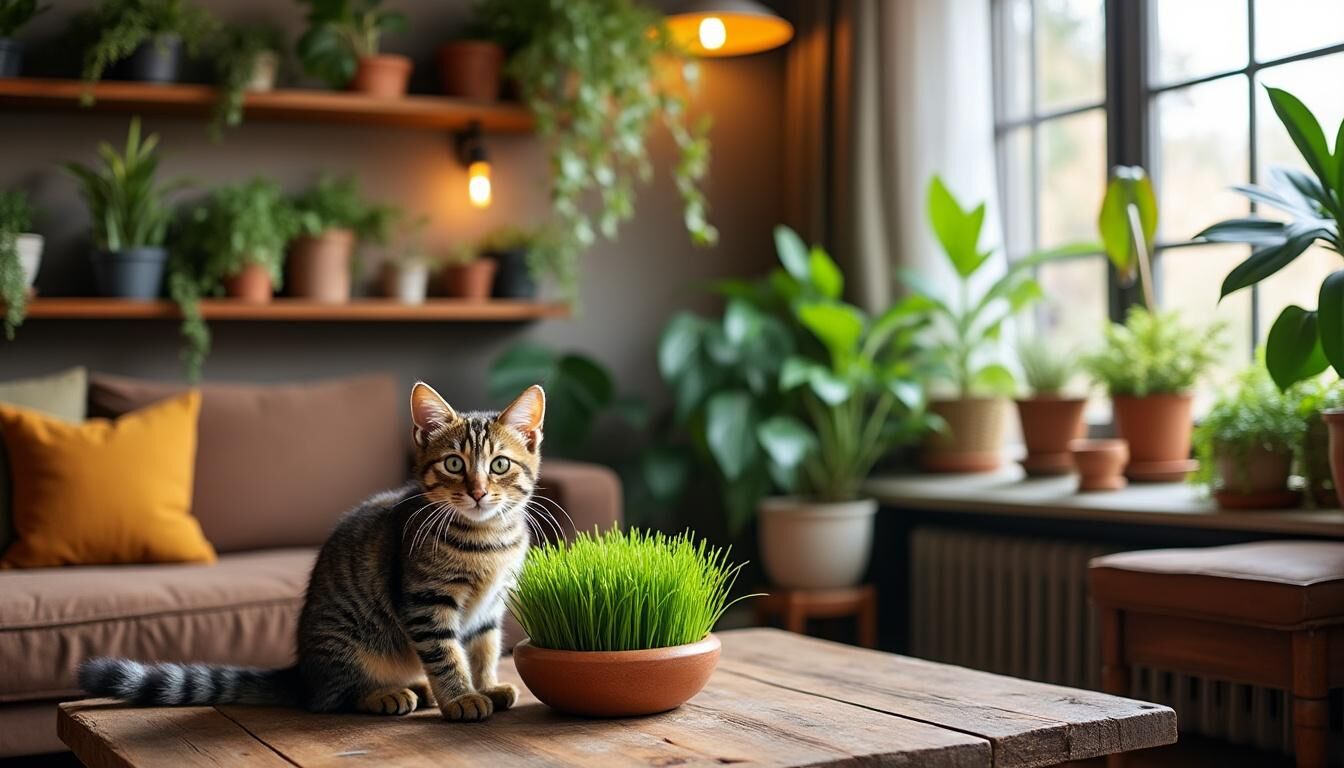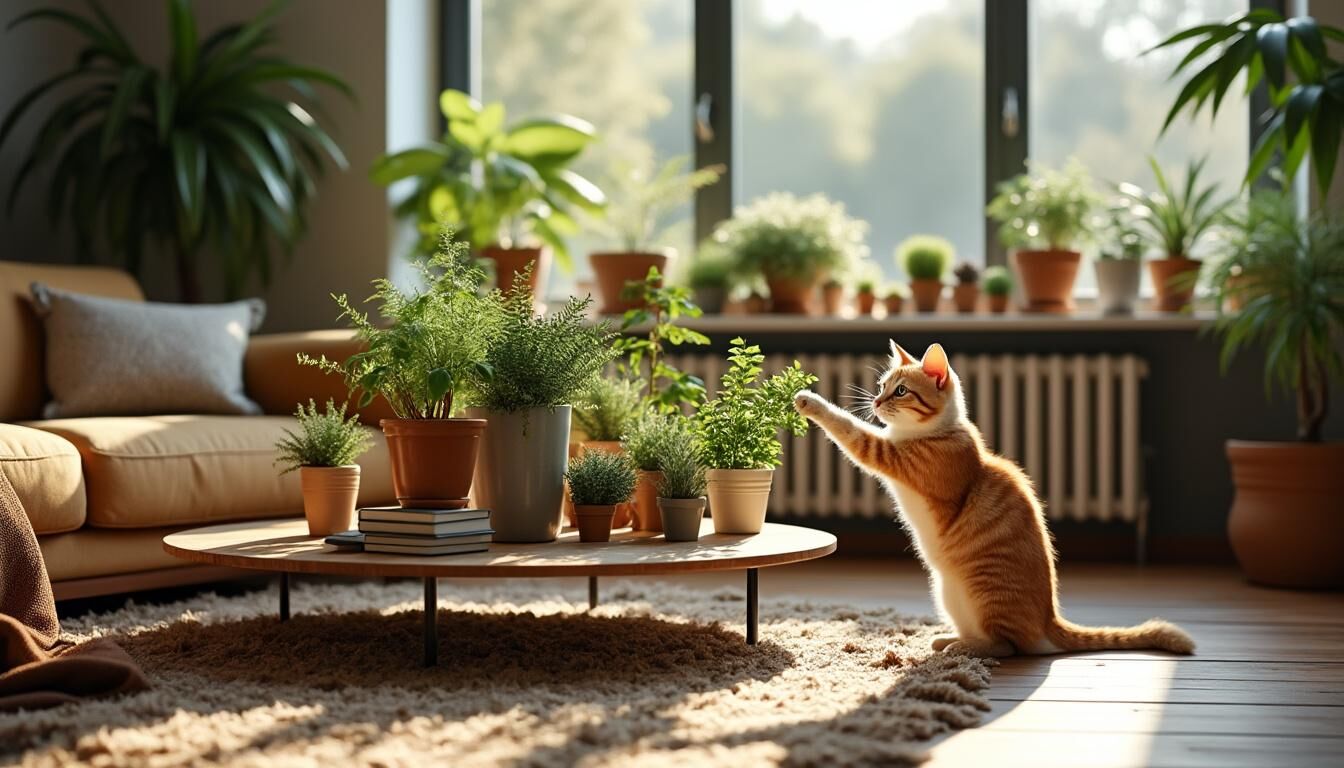Cats often exhibit curious behaviors driven by instinct and environment, one of which is their tendency to nibble on houseplants. This common interaction between felines and indoor greenery can puzzle many cat owners, especially when it results in damaged plants or concerns about their pet’s health. Understanding why cats are attracted to plants is essential for providing solutions that honor both the cat’s natural inclinations and the owner’s desire to maintain a safe, vibrant environment. Cats may chew or dig in plants not out of mischief but to seek sensory stimulation, alleviate stress, or fulfill nutritional needs. However, this behavior can sometimes expose them to toxic plants, making awareness critical. With gentle guidance and appropriate alternatives, cats and plants can coexist in harmony, enhancing the household for both.
Understanding Why Cats Eat Houseplants: Feline Curiosity and Behavior Explained
Common Reasons Cats Are Attracted to Houseplants 🐾
The fascination cats show toward plants stems from several intertwined motivations. A cat’s exploratory nature leads them to interact with new objects in their environment, including houseplants. Here are some prominent reasons cats might consistently approach or chew plants:
🧠 Curiosity: Cats are naturally inquisitive animals. The texture, smell, and movement of plant leaves when touched can intrigue them.
😌 Stress Relief: Boredom or anxiety often triggers behaviors like chewing plants due to the tactile comfort this provides.
🍃 Dietary Supplementation: Occasionally, cats eat plants to introduce fiber into their diet or to help with digestion.
🎯 Playfulness: They might treat leaves as toys, batting or biting them for simple amusement.
🐾 Attention-Seeking Behavior: Sometimes, cats learn that interacting with plants earns a reaction from their owners.
For example, in multi-cat households, one cat may exhibit plant-biting behavior, motivating others to join simply from peer influence. This social reinforcement makes understanding group dynamics important in managing such behaviors.
Natural Instincts: Exploring Texture and Chewing Behaviors
Cats have evolved as obligate carnivores, but chewing on fibrous plant material taps into their ancestral habits. Investigations reveal that the rough or smooth textures of leaves appeal to certain cats’ sensory preferences. The act of chewing mimics hunting or grooming behavior, which can provide mental stimulation and satisfy oral needs.
These instincts are influenced by several biological factors:
🦷 Tactile Satisfaction: Oral exploration helps with teething in kittens or provides comfort to adults.
⚙️ Digestive Aid: Grass ingestion encourages vomiting to clear hairballs or intestinal irritants.
🌿 Natural Selection: In the wild, cats consume grasses occasionally to access certain nutrients not found in prey.
Veterinarians often note that allowing access to safe grasses like cat grass can reduce destructive chewing elsewhere in the home. Yet, it’s essential to monitor because not all plants are suitable for this purpose.
Boredom and Environmental Factors That Trigger Plant Chewing
Boredom is among the leading environmental contributors to plant-chewing behavior. A lack of sufficient stimulation or interaction can lead cats to seek entertainment or stress relief through whatever is accessible—in this case, plants. Stressful conditions such as sudden changes in the household, lack of playtime, or insufficient environmental complexity can heighten this tendency.
Owners can recognize boredom-driven chewing when the cat:
😿 Focuses on plants mainly during inactive periods.
😼 Exhibits repetitive mouth movements or restless pacing.
🪧 Shows increased vocalization or attention-seeking gestures around plants.
Environmental enrichment, including interactive toys and accessible climbing spaces, can significantly reduce boredom-related behaviors. Cats thrive when their natural instincts are engaged, and when their environment offers diverse opportunities for exploration and play.
Houseplants and Cat Safety: Identifying Toxic Plants and Safer Alternatives
Recognizing Dangerous Plants for Cats: Symptoms of Plant Toxicity 🚫
Many popular houseplants pose risks to cats due to toxic compounds. Consumption of such plants can lead to serious health issues, from mild irritation to life-threatening conditions. Recognizing symptoms early is crucial for timely intervention. Common signs of plant toxicity in cats include:
🤢 Vomiting or drooling excessively
😵 Lethargy and weakness
🩸 Diarrhea or abdominal pain
👁️ Eye irritation or redness
💨 Difficulty breathing or coughing
Plants such as lilies, philodendrons, and poinsettias are infamous for being highly toxic to cats. The ASPCA offers an extensive list of hazardous plants for owners to consult. Veterinary advice is vital if ingestion is suspected, as some toxins require immediate treatment to prevent permanent damage.
🌿 Plant | ⚠️ Toxicity Level | 🚑 Common Symptoms |
|---|---|---|
Lilies | High | Kidney failure, vomiting, lethargy |
Philodendron | Moderate | Oral irritation, swelling, drooling |
Poinsettia | Low to moderate | Vomiting, mild irritation |
Dieffenbachia | Moderate | Difficulty swallowing, oral pain |
Non-Toxic Houseplants: Safe Greenery Options for Cat-Friendly Homes 🪴
To harmonize the presence of plants and cats, selecting non-toxic plants is a priority. These safe plants satisfy the aesthetic desire to keep indoor greenery while minimizing health risks for the cat. Options that generally pose no danger include:
🌾 Spider Plant: Hardy and visually appealing, with minimal toxicity risk.
🌵 Bamboo Palm: Adds tropical flair and is safe for cats.
🍃 Boston Fern: Soft fronds that cats usually avoid chewing aggressively.
Cat-Safe Plant Alternatives: Cat Grass, Catnip, and Edible Herbs
Directly catering to a cat’s instinctive plant consumption can be done with purpose-grown plants that offer both enjoyment and health benefits. These include:
🌱 Cat Grass: Typically a mixture of wheat, oat, or rye grasses that aid digestion.
💚 Catnip: Valued for its euphoric effects and safe in small amounts when chewed.
🌿 Edible Herbs: Parsley, basil, or thyme, which can provide sensory enrichment.
These alternatives can redirect cats from toxic houseplants to safe greens, fulfilling their chewing desires without health risks.
Toxic vs. Non-Toxic Plants: What Every Cat Owner Should Know
The distinction between toxic and non-toxic plants is fundamental to maintaining a pet-safe environment. Educating oneself about which plants fall into each category helps in selecting appropriate greenery and organizing the home layout.
Key points include:
✔️ Always research a plant’s toxicity before purchase or placement.
✔️ Observe your cat’s behavior closely after introducing new plants.
✔️ Keep toxic plants out of reach or avoid them entirely.
✔️ Consult a veterinarian promptly if any ingestion symptoms arise.
Compiling a clear chart or list of plants at home can help track risk and guide decisions on plant care and placement.
Natural and Physical Deterrents to Keep Cats Away from Houseplants
Scent-Based Deterrents: Citrus, Coffee Grounds, and Other Safe Options 🍊
Cats are known to dislike certain smells, which can be leveraged as natural deterrents to keep them from chewing or digging in plants. Citrus peels from oranges and lemons have a strong, unpleasant odor to cats and are a safe and effective option. Additionally, coffee grounds sprinkled on the soil can deter cats without harmful effects.
🍊 Citrus peels provide a fresh scent that cats avoid.
☕ Coffee grounds add texture and scent repellent qualities.
🌿 Peppermint oil diluted in water can serve as a spray deterrent when applied near plants.
🌲 Pine needles scattered on soil surfaces discourage digging.
These deterrents are affordable and simple to implement, enhancing plant safety without causing feline distress.
Dangerous Deterrents to Avoid: Essential Oils and Spicy Substances 🚫
Not all deterrents are safe for cats, even if they seem natural. Avoid using essential oils like tea tree, eucalyptus, or cinnamon as sprays around plants, as they can cause respiratory distress and other toxic effects in felines. Similarly, substances like cayenne pepper or spicy powders, sometimes suggested as deterrents, are harmful to a cat’s sensitive nose and digestive system.
Veterinarians strongly advise against:
🧴 Use of undiluted or high-concentration essential oils
🌶️ Any spicy irritants applied near plants
⚠️ Chemical repellents not certified for pet safety
Maintaining cat health must remain a priority when choosing deterrent methods.
Physical Barriers: Aluminum Foil, Pinecones, and Creative Solutions
A practical way to prevent cats from accessing plants is to create physical obstacles that make digging or chewing uncomfortable. Items such as aluminum foil laid over plant soil can deter cats due to the foil’s texture and noise when disturbed.
🧊 Aluminum foil covers prevent soil digging
🌰 Pinecones scattered around plants create a rough barrier
🍳 Plastic eggs or forks embedded in the soil serve as tactile deterrents
🪨 Clay pebbles (LECA) atop soil help block digging and moisture loss
These barriers offer non-harmful, creative ways to discourage unwanted feline interactions while remaining environmentally friendly.
Innovative Plant Placement: Hanging Baskets and High Shelves 🏠
Positioning plants out of a cat’s reach is one of the simplest and most effective strategies. Cats who enjoy climbing or jumping provide an opportunity to locate plants in hanging baskets or on tall shelves where they remain inaccessible.
🔝 Use window-mounted or ceiling-hung planters
📚 Place plants on shelves secured away from cat jump paths
🚪 Create dedicated plant zones in rooms closed off to pets
This approach not only protects the houseplants but also respects the cat’s natural abilities, reducing the likelihood of conflict.
Covering Soil and Preventing Digging: Practical Tips
Cats are attracted to the loose texture of soil for digging or toileting, which can damage plants and create messes. Covering soil effectively discourages this behavior. Useful materials for coverage include:
🪨 Smooth stones or pebbles
🌱 Decorative moss layers
🍂 Pine needles or bark chips
🧴 Commercially available deterrent soils or tapes designed for cats
Regularly refreshing these coverings and combining them with scent deterrents provides robust protection for plant soil integrity.
Redirecting Cat Behavior and Enriching Your Home Environment
Providing Alternative Greens and Safe Chewing Options for Cats
Fulfilling a cat’s need to chew plants with specifically intended alternatives is highly beneficial. Offering cat grass or catnip near their feeding or lounging areas creates positive associations. Other edible herbs like parsley or cilantro can also diversify their safe plant options.
🌱 Place fresh cat grass accessible at all times
🌿 Rotate herbs and catnip to maintain novelty
💡 Consider small potted greens outdoors during supervised sessions
Such redirection satisfies behavioral needs while safeguarding treasured houseplants.
Environmental Enrichment: Toys, Scratching Posts, and Playtime 🎾
Engaging a cat’s natural hunting and exploratory instincts through play can reduce destructive plant chewing. Toys, vertical climbing posts, and interactive play sessions provide mental and physical outlets.
🧶 Interactive wand toys stimulate predatory behavior
🪜 Cat trees and climbing shelves expand vertical territory
🎾 Puzzle feeders engage cognitive skills and feeding drive
Well-enriched environments decrease stress and boredom, essential triggers for unwanted plant interactions.
Positive Reinforcement Training: Teaching Cats to Avoid Houseplants
Consistency and patience are key in behavioral modification. Training cats to avoid plants requires gentle encouragement and rewards for success, rather than punishment.
🍬 Offer treats or affection when cats stay away from plants
🛎️ Use clicker training or click-and-treat methods
↩️ Redirect attention calmly to toys or acceptable chewing targets
⏳ Be patient and persistent over time
Positive training builds trust and understanding between owner and pet, promoting long-term harmony.
Addressing Common Issues: Litter Box Needs and Soil Digging
Sometimes cats dig in plant soil due to insufficient or aversive litter box conditions. Ensuring the litter box is clean, appropriately sized, and placed in a quiet location can mitigate this behavior.
🧼 Provide multiple clean litter boxes if multi-cat household
📍 Place litter boxes in accessible, low-traffic areas
💧 Use litter types preferred by the individual cat
🪨 Cover plant soil to discourage digging
Addressing the root cause helps resolve unwanted plant soil interactions while prioritizing feline comfort.
Monitoring Cat Health: Spotting Plant Ingestion Warning Signs
Vigilance in observing a cat’s health is crucial after any suspected plant consumption, particularly when toxicity is possible. Owners should watch for:
🤢 Vomiting or excessive drooling
😔 Withdrawal or reduced activity
🩸 Diarrhea or unusual vocalizations
If symptoms appear, immediate consultation with a veterinarian is advised. Early treatment can prevent serious complications. Routine health checks ensure that behavioral and environmental strategies align with the cat’s well-being.
🚨 Symptom | 🩺 Potential Cause | ⚕️ Recommended Action |
|---|---|---|
Vomiting | Plant toxicity or hairball issues | Seek veterinary evaluation promptly |
Excessive drooling | Oral irritation or poisoning | Remove access to plants, consult vet |
Lethargy | Systemic toxicity or stress | Immediate veterinary care recommended |

Frequently Asked Questions
Why do cats eat plants even though they are carnivores?
Cats chew plants to satisfy instinctual behaviors like aiding digestion, exploring textures, or combating boredom. Though primarily meat-eaters, they instinctively consume grass or greens to help with clearing hairballs or to get trace nutrients.
Which houseplants are safest to keep around cats?
Safe options include spider plants, bamboo palms, Boston ferns, and purpose-grown cat grass or catnip. Avoid toxic plants like lilies or philodendrons to ensure your cat’s safety.
Can scents really keep cats away from plants?
Yes. Cats dislike citrus and coffee grounds smells, making these natural deterrents effective. However, avoid dangerous substances like essential oils or spicy powders, which can harm cats even if they repel.
How can training help reduce a cat’s plant-chewing behavior?
Training with positive reinforcement encourages cats to avoid plants by rewarding desirable behavior. Consistency, patience, and gentle redirection help cats learn boundaries without fear or stress.
What signs indicate a cat has ingested a toxic plant?
Symptoms include vomiting, excessive drooling, lethargy, diarrhea, and difficulty breathing. If these occur, consult a veterinarian immediately for professional diagnosis and treatment.

